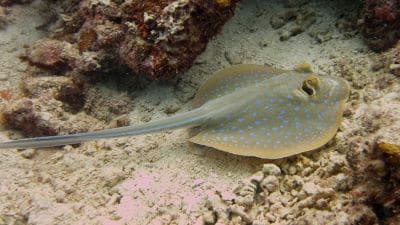Home › Destinations › Asia › Thailand › Koh Tao › Laem Thian
Laem Thian Dive Sites in Koh Tao
The rocky coastline on the eastern side of Koh Tao is somewhat remote and less travelled. So, you will need a boat to reach the best dive sites.
Even so, the popular diving spots at Ao Laem Thian are excellent locations for beginners to explore the shallow bay and for experienced divers to go deeper at Laem Thian Caves.
What's the Best Season to Dive at Koh Tao?
There are 44 sun-drenched islands in the Chumphon Archipelago. But, the major hot spots for diving and snorkeling are:
- Koh Phangan
- Koh Samui Island
- Koh Tao (Turtle Island)
- Mu Ko Chumphon National Park
Koh Tao is a compact kidney-shaped island that has about twenty one (21) square kilometres of total land mass.
Nonetheless, the pristine white sand beaches and azure blue water has transformed Koh Tao Island into one of the best places for scuba diving in Thailand.
Here's the thing:
Most scuba divers want to explore destinations that are sunny and have calm conditions underwater. Well, Koh Tao has over three hundred days of year-round sunshine and the temperature of the water is a constant 29° Celsius (84° Fahrenheit).
As a consequence of that, it's fair to say diving in Koh Tao is an annual activity. But, divers need to be mindful that the southwest monsoons usually arrive towards the end of October and may continue until the end of January.
At certain times of the year, the south western gulf can have thirty (30) metres of underwater visibility. Hence, the best months for divers to enjoy clear water dives are July, August, and September.
Pro Tip: Check out our sea life section for interesting facts about whale sharks that tend to make an appearance around the islands near Koh Tao during the months of April and May.
Aquatic Animals at Laem Thian
The island of Ko Tao is smaller than Koh Phangan (about 45 kilometres to the south) and Koh Samui. Even so, the underwater scenery is better for divers who enjoy swimming around coral-encrusted rock pinnacles and diving on shallow artificial wreck structures.
Koh Tao dive sites are good places to see big fishes (e.g. pelagics). Plus, divers should expect to catch sightings of macro marine life as well, especially during the months for plankton blooms (e.g. March and April), including:
- Bluespotted ribbontail ray
 Butterflyfish
Butterflyfish- Green humphead parrotfish (Bolbometopon muricatum)
- Juvenile harlequin sweetlips
- Nudibranch sea slug
- Orangespine unicornfish
- Ringed pipefish (Dunckerocampus dactyliophorus)
- Wart slugs (Phyllidia varicosa)
- Xestospongia muta (giant barrel sponge)
- Yellow boxfish (Ostracion cubicus)
The island has become a key breeding ground for large marine reptiles, such as hawksbill and green turtles. There are regular events to reintroduce juvenile turtles back into the vibrant ecosystems and help stimulate the growth of colourful coral reefs.
Diving at Laem Thian Bay and Caves
There are two points of interest for scuba divers in Laem Thian. But, the underwater topography is not the same at both sites, and they have very different depth levels.
For example:
The shallow dive site at Laem Thian Bay ranges between five (5) and fifteen (15) metres deep. In other words, this spot is ideal for conducting basic scuba skills with trainee divers near the southern beach.
Furthermore, the large boulders that you'll see in the rugged and rockbound cove extend from the shoreline all the way down to the ocean floor.
As a result, this is the place to catch sightings of yellowtail barracudas schooling and hunting around the inner reef slopes.
Laem Thian Caves Dive Site
Whereas, diving at Laem Thian Caves is a different prospect altogether. The combination of large granite boulders, and a gathering of hard coral formations, is striking.
This area provides plenty of shelter for colourful reef fishes to shoal near the outer edges of the inlet. Dive a little deeper, and you'll notice that the underwater landscape changes to large rock slabs and a few fringing soft corals (e.g. bubble coral (Plerogyra sinuosa), fan coral).
Go down even deeper (15 to 22 metres), and you get an opportunity to dive the rocky overhangs that extend out from the wall.
There are small caverns and cave entrances to explore and several exciting swim-throughs and archways for divers to navigate.
Look out for a solitary titan triggerfish, feeding on sea urchins, and the beautiful Wiebel's butterflyfish (Chaetodon wiebeli) towards the end of the dive.
Pro Tip: Another section contains information about the cavern and cave diving certification available through the Professional Association of Diving Instructors (PADI®).
Related Information and Help Guides
- Aow Leuk and Hin Ngma Dive Sites Southeast Koh Tao
- Hin Wong Bay Dive Site Koh Tao East Coast in Thailand
- HTMS Sattakut Koh Tao Shipwreck Location and History
- Dive Details about the Shark Island Location at Koh Tao
- Chumphon Pinnacle | Is it the Best Place to Dive in Koh Tao?
- Sail Rock Dive Site in the Lower Gulf of Thailand
- Koh Samui Scuba Diving and Snorkeling Sites
- Where are the Best Shipwreck Dives in Thailand?
Note: The short video [59 seconds] presented by "Black Turtle Dive" contains footage of the breathtaking marine life found at Laem Thian dive site on the east coast of Koh Tao (Turtle Island).